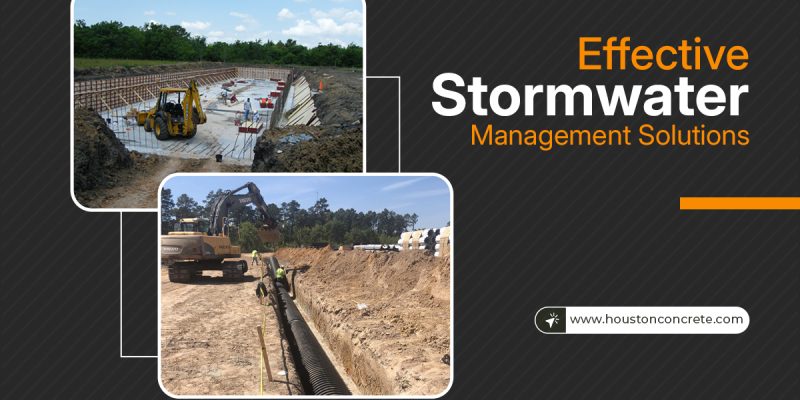Understanding On-Site Stormwater Detention
On-site stormwater detention plays a vital role in modern construction and urban planning. As cities expand and land becomes increasingly developed, managing stormwater effectively is essential to prevent flooding, erosion, and environmental damage.
This method involves temporarily storing stormwater on a property and gradually releasing it into the public drainage system or natural water bodies. On-site stormwater detention systems help prevent overwhelming local drainage infrastructure, reducing the risk of waterlogging and property damage. These systems are commonly used in commercial, industrial, and residential projects to comply with local regulations and ensure responsible water management.
Why On-Site Stormwater Detention Matters
The increasing impact of urbanization has made stormwater management a priority for municipalities, property developers, and homeowners. Some key reasons why on-site stormwater detention is essential include:
- Flood Prevention: By controlling water runoff, these systems reduce the risk of flash floods, which can cause costly damage to buildings, roads, and landscapes.
- Erosion Control: Uncontrolled water flow can erode soil, damaging foundations, roads, and vegetation. Proper detention systems help mitigate this issue.
- Improved Water Quality: When stormwater is detained, it allows pollutants and sediments to settle before the water is released into the drainage system, reducing contamination of natural water sources.
- Regulatory Compliance: Many municipalities require property owners and developers to implement on-site stormwater detention systems to meet local drainage and environmental guidelines.
- Sustainable Development: Proper stormwater management supports green infrastructure initiatives, promoting long-term environmental sustainability.
Exploring Underground Stormwater Detention Systems
While traditional on-site stormwater detention solutions often involve surface-level retention ponds or tanks, underground stormwater detention systems provide an innovative and space-efficient alternative. These systems are particularly beneficial in urban areas where land is limited.
What Are Underground Stormwater Detention Systems?
Underground stormwater detention systems consist of large, durable structures installed beneath the ground to store and slowly release stormwater. These systems can be made of concrete, plastic, or metal and are designed to handle varying capacities based on site-specific requirements.
Benefits of Underground Stormwater Detention Systems
- Maximized Land Use: Unlike surface detention ponds, underground stormwater detention systems do not take up valuable space. This allows developers to utilize the land for parking lots, green spaces, or additional buildings.
- Aesthetic Preservation: Since these systems are installed underground, they do not impact the visual appeal of a property, making them ideal for urban and commercial developments.
- Environmental Advantages: By promoting water infiltration, underground stormwater detention systems can help replenish groundwater supplies and support natural ecosystems.
- Structural Durability: These systems are designed to withstand heavy loads, making them suitable for installation under parking lots, roads, and industrial sites.
- Long-Term Cost Efficiency: Properly designed and maintained detention systems can significantly reduce the costs associated with stormwater damage and infrastructure repairs.
How On-Site Stormwater Detention Systems Work
Effective on-site stormwater detention relies on a combination of collection, storage, and controlled release. The process typically involves the following steps:
- Collection: Stormwater runoff is captured from rooftops, parking lots, and other impervious surfaces using gutters, drains, and channels.
- Storage: The collected water is directed into a detention basin, tank, or underground stormwater detention system where it is held temporarily.
- Controlled Release: The detained water is gradually discharged into the municipal drainage system or natural water bodies at a controlled rate to prevent flooding and erosion.
- Filtration and Treatment: Some systems incorporate filtration mechanisms to remove debris, sediments, and pollutants before the water is released.
Choosing the Right Stormwater Detention System
When selecting an on-site stormwater detention system, several factors must be considered to ensure efficiency and compliance with local regulations. Key considerations include:
1. Site Conditions
- Soil type and permeability
- Available land area
- Proximity to existing drainage infrastructure
2. Storage Capacity Requirements
- Expected volume of stormwater runoff
- Local rainfall patterns and climate conditions
- Regulatory storage capacity mandates
3. Material Selection
- Concrete, metal, or plastic detention structures
- Durability and maintenance requirements
- Load-bearing capacity for underground installations
4. Cost and Maintenance
- Initial installation and long-term maintenance costs
- Frequency of inspections and required servicing
- Accessibility for routine maintenance and cleaning
Maintenance of Stormwater Detention Systems
Proper maintenance is essential to ensure the long-term effectiveness of on-site stormwater detention and underground stormwater detention systems. Regular inspections and servicing can prevent blockages, structural damage, and reduced efficiency. Maintenance tasks include:
- Debris Removal: Clearing drains, gutters, and detention basins of leaves, trash, and sediments.
- Inspection of Structural Integrity: Checking for cracks, leaks, and erosion in detention tanks and piping systems.
- Vegetation Management: Trimming overgrown vegetation around detention basins to prevent clogging and maintain water flow.
- Monitoring Water Quality: Testing for pollutants and contaminants to ensure compliance with environmental regulations.
Stormwater Detention Solutions by Bill Houston Concrete Construction
For property owners and developers seeking reliable stormwater management solutions, Bill Houston Concrete Construction offers professional design and installation services for on-site stormwater detention and underground stormwater detention systems. With years of experience in the industry, their team specializes in creating customized solutions that meet regulatory requirements while maximizing efficiency and sustainability.
Their services include:
- Comprehensive Site Assessments: Evaluating drainage needs and regulatory requirements.
- Custom System Design: Tailoring on-site stormwater detention solutions to specific project requirements.
- High-Quality Installation: Ensuring durable, long-lasting detention systems using top-grade materials.
- Ongoing Maintenance Support: Providing routine inspections and servicing to ensure optimal system performance.
For more information on stormwater detention solutions, visit Houston Concrete’s website.
Conclusion
On-site stormwater detention and underground stormwater detention systems are essential components of modern stormwater management. Whether for commercial, industrial, or residential developments, implementing effective detention systems helps prevent flooding, control erosion, and improve water quality. By choosing a professional and experienced service provider like Bill Houston Concrete Construction, property owners can ensure compliance with regulations while optimizing their land use and infrastructure.
For expert stormwater detention solutions, trust Bill Houston Concrete Construction to deliver high-quality, customized systems that meet your project’s needs.

